Intel NUC 12 Pro Wall Street Canyon Kits Review: Alder Lake in UCFF Avatar
by Ganesh T S on January 26, 2023 11:30 AM ESTGPU Performance: Synthetic Benchmarks
Intel did not make significant changes in the integrated GPU when moving from Tiger Lake to Alder Lake. Process maturity has allowed it to clock the iGPU a bit higher, but the number of EUs remains the same as in the previous generation. GPU performance evaluation typically involved gaming workloads, and for select PCs, GPU compute. Prior to that, a look at the capabilities of the GPU in the NUC 12 Pro kits is warranted.
The Intel Iris Xe Graphics in the NUC 12 Pro kits is an integrated GPU based on a reworked scalable architecture. The performance of the iGPU is miles ahead of previous iGPUs from both Intel and AMD, as the benchmarks below show.
GFXBench
The DirectX 12-based GFXBench tests from Kishonti are cross-platform, and available all the way down to smartphones. As such, they are not very taxing for discrete GPUs and modern integrated GPUs. We processed the offscreen versions of the 'Aztec Ruins' benchmark.
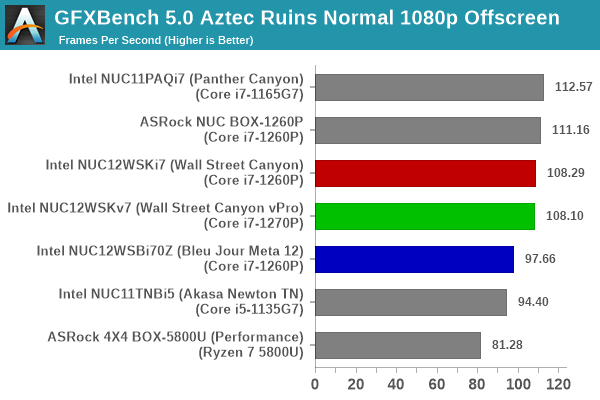
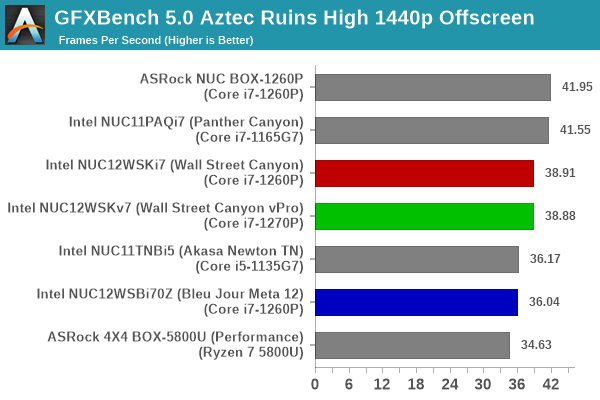
Panther Canyon has a slightly higher PL2 (67W) that gives it a bit of an edge. However, the power budget allocation in the ASRock Industrial unit to the iGPU seems to be better than the one in the NUC 12 Pro units, and that translates to the NUC 12 Pro kits coming in the middle of the pack. However, the scenario changes when offscreen considerations are dropped.
UL 3DMark
Four different workload sets were processed in 3DMark - Fire Strike, Time Spy, Night Raid, and Wild Life. The results below consistently show the actively-cooled NUC 12 Pro kits performing much better than the other systems in the mix. A combination of faster clocks and higher power budgets appear to be the reason behind this.
3DMark Fire Strike
The Fire Strike benchmark has three workloads. The base version is meant for high-performance gaming PCs. It uses DirectX 11 (feature level 11) to render frames at 1920 x 1080. The Extreme version targets 1440p gaming requirements, while the Ultra version targets 4K gaming system, and renders at 3840 x 2160. The graph below presents the overall score for the Fire Strike Extreme and Fire Strike Ultra benchmark across all the systems that are being compared.
| UL 3DMark - Fire Strike Workloads | |||
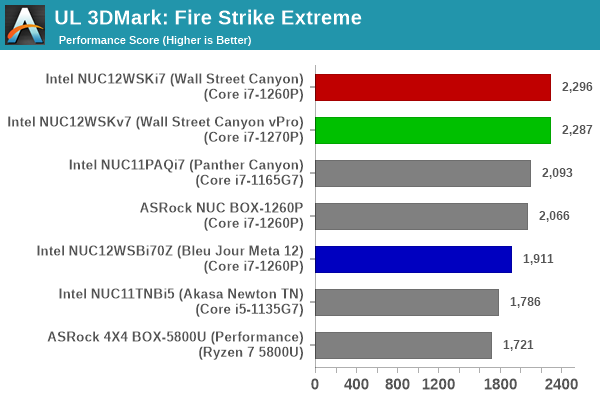
3DMark Time Spy
The Time Spy workload has two levels with different complexities. Both use DirectX 12 (feature level 11). However, the plain version targets high-performance gaming PCs with a 2560 x 1440 render resolution, while the Extreme version renders at 3840 x 2160 resolution. The graphs below present both numbers for all the systems that are being compared in this review.
| UL 3DMark - Time Spy Workloads | |||
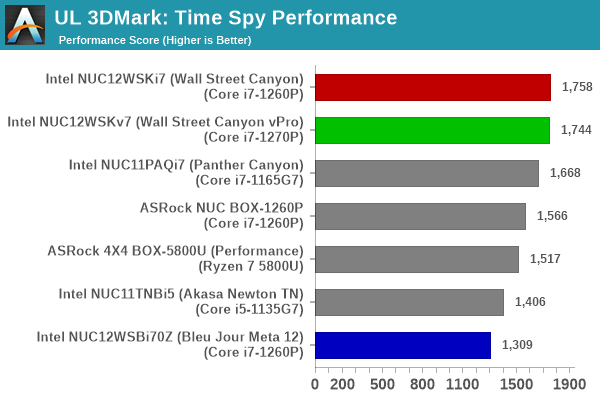
3DMark Wild Life
The Wild Life workload was initially introduced as a cross-platform GPU benchmark in 2020. It renders at a 2560 x 1440 resolution using Vulkan 1.1 APIs on Windows. It is a relatively short-running test, reflective of mobile GPU usage. In mid-2021, UL released the Wild Life Extreme workload that was a more demanding version that renders at 3840 x 2160 and runs for a much longer duration reflective of typical desktop gaming usage.
| UL 3DMark - Wild Life Workloads | |||

3DMark Night Raid
The Night Raid workload is a DirectX 12 benchmark test. It is less demanding than Time Spy, and is optimized for integrated graphics. The graph below presents the overall score in this workload for different system configurations.
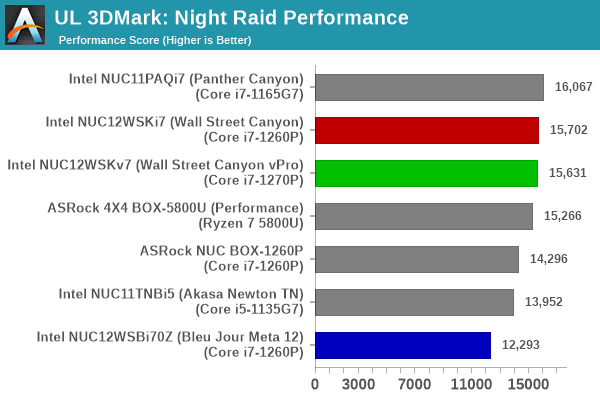











25 Comments
View All Comments
abufrejoval - Sunday, January 29, 2023 - link
In the PC market, even "small" niches seem to be big enough to merit a product, otherwise Intel wouldn't keep on doing them.My main NUC use case is µ-servers in a 10Gbit cluster using cheap cascaded KVMs in the rare case I need the console. Near silent and low average power 24x7 operation is the goal, with enough peak power to get things done in a hurry.
Yes, you could build that from laptops, but unfortunately the ones that offer 64GB RAM and 2-8TB of NVMe as well as a TB port for 10GBit Ethernet are designed for gamers and carry quite a hefty premium and extras I don't need.
In corporate workplaces laptops have pretty much replaced small form factor PCs, even more so with the pandemic. But there are still quite a lot of profesisonal installations in public services, medical care and production, where NUCs mounted to a firmly attached display are quite the ticket.
Personally, I'd prefer to have Mini-ITX board variants for every NUC Intel builds, but that really seems too niche these days.
ottonis - Friday, March 17, 2023 - link
A NUC can be a tremedously useful device to power up a basic digital audio workstation (DAW), alongside external audio and midi devices. It has enough processing power to run even the most modern DAW (e.g. studio one) alongside a bunch of virtual instruments and effects. Once everything is installed and up and running, it may be useful to deactivate Wifi, Bluetooth and LAN and to purge the autostart menu from all but the most essential scripts and programs, in order to reduce DPC latency.It is so compact that it a dream come true for musicians wanting to save precious space in the homerecording studios or who are on the run and on tour and need to travel as light as possible.
So, if you know how to set this device up, it is an invaluable tool for musicians.
It's benefit over laptops: it has more I/O. I struggled to connect all my external devices with an otherwise great laptop, but the NUC can handle them all (4x USB-A + 2x USB-C)
CyrIng - Saturday, January 28, 2023 - link
The blue carton box has a better look than the NUC case.About Hybrid processors, CoreFreq is now monitoring Pcore and Ecore, including their own Turbo tunable tweaks
ISO available at www.cyring.fr
abufrejoval - Sunday, January 29, 2023 - link
The GPU-Z data is obviously bollocks: I was first thrown off by the low memory bandwidth of 25GB/s, which is really what DDR3 based GT3 solutions or single channel DDR4 might do (64-bit width may be another hint, because it's 128-bit on dual channel).I am seeing more like 40GB/s on my various Xe's, 38.4GB/s on an i7-1165G7 and 42GB/s on an i5-12500H with an 80EU Xe, both using DDR4-3200 SO-DIMMs.
But it's the pixel and texture fill rates and the GPU boost clocks where things must have been read wrong, nothing clocks 11GHz on CMOS just yet and the fill rates are matching the RTX2060 on my NUC11PHBi7 using GDDR6, 10GPixels and 21 GTexels are more realistic with 1.3GHz boost.
So please recheck the setup and data.
abufrejoval - Sunday, January 29, 2023 - link
It's too bad how Intel often just manages to get withini >90% of what I want, only to bungle it on the final stretch...The "blue day meta" variants (what on Earth did they smoke?) are rather intriguing because they seem to allow screwing say a Noctua fan on top (is there a matching fan connector on the board?): that could fix the major isse with the NUCs, too little volume/mass for cooling 20-30 Watts at acceptable noise levels.
What's critically missing for me, is the Thunderbolt ports, which I need for 10GBit networking, be it via Ethernet or TCP over TB. I believe those parts may still be in short supply, but I'd always pay €20-30 extra to have those ports.